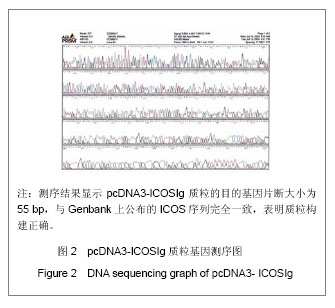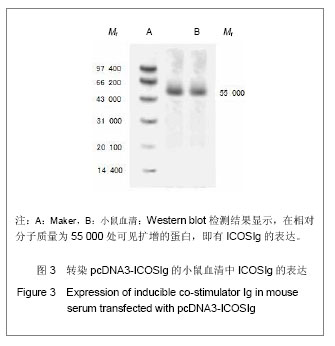中国组织工程研究 ›› 2013, Vol. 17 ›› Issue (37): 6641-6644.doi: 10.3969/j.issn.2095-4344.2013.37.016
• 组织构建基础实验 basic experiments in tissue construction • 上一篇 下一篇
真核表达载体pcDNA3-ICOSIg的构建及表达
赵国华1,张 睿2,许国岩3,王冬梅4
- 辽宁省肿瘤医院,1胃外科,2大肠外科,辽宁省沈阳市 110042;3沈阳市铁西区华康医院外科,辽宁省沈阳市 110026;4辽宁陆军预备役高射炮一师三团,辽宁省沈阳市 110048
Construction and expression of eukaryotic expression vector pcDNA3-ICOSIg
Zhao Guo-hua1, Zhang Rui2, Xu Guo-yan3, Wang Dong-mei4
- 1Department of Gastric Surgery, 2Department of Colorectal Surgery, Liaoning Cancer Hospital, Shenyang 110042, Liaoning Province, China;3Department of Surgery, Huakang Hospital of Shenyang, Shenyang 110026, Liaoning Province, China;4Regiment 3, Division 1 Anti-aircraft Artillery, Liaoning Army Reserve, Shenyang 110048, Liaoning Province, China
摘要:
背景:人可诱导共刺激分子(ICOS)是迄今发现的重要共刺激分子家族成员,可促进激活T细胞的增殖和分泌、调节Th1/Th2细胞的极化、增强依赖T细胞的B细胞功能,阻断ICOS共刺激信号会导致T细胞的克隆失活或克隆无反应,从而诱导肿瘤对机体的免疫逃逸。 目的:构建表达ICOSIg的质粒,观察其在小鼠体内的表达。 方法:克隆编码ICOS的胞外片段,将其与编码小鼠免疫球蛋白IgG恒定片段(Ig)的基因融合,构建ICOSIg融合基因及其分泌型真核表达载体pcDNA3-ICOSIg,酶切鉴定重组子,测序,利用阳性脂质体载体包被pcDNA3-ICOSIg转染小鼠右侧大腿肌肉组织,Western blot法检测血清ICOSIg水平。 结果与结论:经测序鉴定证实pcDNA3-ICOSIg质粒目的基因片断与Genbank上公布的ICOS序列完全一致,说明质粒构建成功。脂质体载体包被pcDNA3-ICOSIg转染小鼠7 d,在小鼠血清中检测到ICOSIg的阳性表达,说明pcDNA3-ICOSIg能够在小鼠肌细胞内表达。证实利用基因合成和重组技术可成功构建真核表达载体pcDNA3-ICOSIg。
中图分类号:


.jpg)
.jpg)